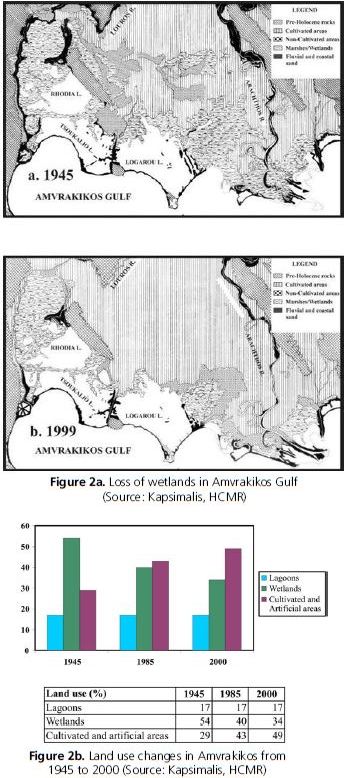5.4 Land and water management
The biodiversity and productivity of the lagoons in Greece is threatened by severe anthropogenic pressures such as damming, pollution, water flow modifications, overfishing, alien species and so forth. The increased damming of rivers led to reduced river flow and terrestrial sediment input. An increased nutrient and pollutant influx is associated with agriculture and urban development.
A considerable loss of the wetlands surrounding the coastal lagoons due to the increase of agricultural activities led to a decline of water retention and purification capacity of these ecosystems. Figures 2a and 2b show the decline of Amvrakikos wetlands from 1945 to 1999, due to the increase of artificial and cultivated areas.

Figure 2a. Loss of wetlands in Amvrakikos Gulf (Source: Kapsimalis, HCMR)
Figure 2b. Land use changes in Amvrakikos from 1945 to 2000 (Source: Kapsimalis, HCMR)
The aforementioned changes have a direct effect on lagoon biodiversity and on the quality of goods and services, and consequently affect society welfare. The responses of ecological communities to increased environmental changes led to a variation in the diversity of community composition in many lagoons in Greece. The nutrient enrichment led to a replacement of sea-grasses by opportunistic green macroalgae, while the loss of sea-grass beds and the degradation of the water quality caused a decrease in species diversity and a decline in fish abundance. In some cases such as Papas lagoon in the Ionian Sea, anoxic conditions and release of hydrogen sulphide caused massive mortality of fish and shellfish communities. Some areas of Papas, Aetoliko and Gialova become completely defaunated, especially during summer or early autumn (Reizopoulou & Nicolaidou, 2004; Koutsoubas et al., 2000b).
Another problem is the decrease of lagoon productivity. Data analysis on fish landings from the last decades (20–30 years), indicate a clear trend of decrease in fish production in Greek lagoons (Koutsikopoulos et al., 2007; Koutrakis et al., 2004). This is attributed to the increase of the fishing effort, but also to the environmental alteration of the lagoons due to anthropogenic stressors (pollution, damming, urbanization) and to the processes affecting the coastal areas.